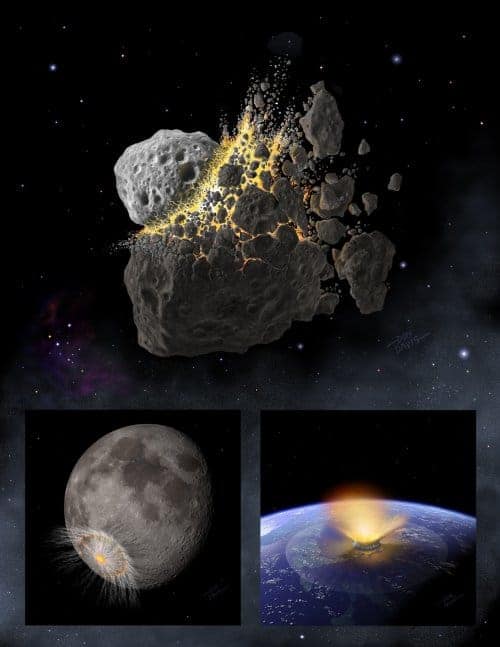It has long been known that a huge object slammed into Mexico’s Yucatan peninsula about 65 million years ago, triggering an environmental catastrophe that almost certainly led to the extinction of the dinosaurs. Now, researchers in the US and the Czech Republic have done computer simulations that suggest that the object was created when two asteroids smashed into each other about 160 million years ago. The object in question is believed to be a chunk of rock 10 km across that was flung into a collision course with Earth (Nature 449 48).

Many scientists believe that the 180 km-diameter Chicxulub crater in Mexico was created by a massive rock that came from the asteroid belt. Lying between between Mars and Jupiter, the belt contains about a million objects that are greater than 1 km in size. Some of these asteroids are grouped in families, which appear to have been created when large asteroids collide with each other.
Now, Bill Bottke and colleagues at the Southwest Research Institute in Colorado and Prague’s Charles University have discovered a new family of asteroids and claim that there is a 90% probability that one of them created the Chicxulub crater. Dubbed the Baptistina asteroid family, the team believe it was formed when two large asteroids about 60 km and 170 km in diameter collided about 160 million years ago. Four different numerical simulations of the underlying of physics of collisions and planetary motion were used to track the origin and subsequent movement of the collision fragments.
The team began by trying to understand how asteroids break up after colliding at more than 10,000 km/h. This was done using numerical “hydrocodes”, which have previously been used to model explosions on Earth including below-ground nuclear blasts. These simulations revealed the size distribution of the collision fragments — information that was then used with measurements of the chemical composition of asteroids to decide which asteroids are members of the Baptistina family.
The team used a second numerical model to simulate how thermal energy from the Sun caused these fragments to slowly shift in their orbits – the so-called Yarkovsky effect. By running these simulations backwards in time, the team concluded that the collision happened 160 million years ago.
The Yarkovsky simulations were then used along with models of how the motions of asteroids are affected by collisions with other asteroids to decide how many large fragments – bigger than about 1 km – managed to make their way to “escape hatches” in the asteroid belt. These are special regions where the gravitational pull of nearby planets such as Jupiter can hurl asteroids into orbits that can put them on a collision course with Earth.
Finally, the team focussed on the motion of the fragments as they pass through an escape hatch and on to Earth. This was done using a fourth computer simulation that works out the trajectories of the fragments by taking into consideration the gravitational pull of the Sun and planets.
The team calculated that tens of asteroids 10 km or larger managed to escape the asteroid belt and that a handful of these managed to strike Earth, along with many smaller objects. This could explain the relatively large number of craters on Earth formed during the Cretaceous period 145 to 65 million years ago. The team also believe that there is a 70% probability that a large Baptistina fragment struck the moon 108 million years ago, creating the 85 km-wide Tycho crater.
The connection between the Baptistina family and Chicxulub is further strengthened by the work of geologists, which suggests that the crater was formed by huge chunk of carbonaceous chondrite, which is also common to the Baptistina family.
Bottke told physicsworld.com that the team is now applying their methods to several other known asteroid collisions that could be related to craters on Earth.



